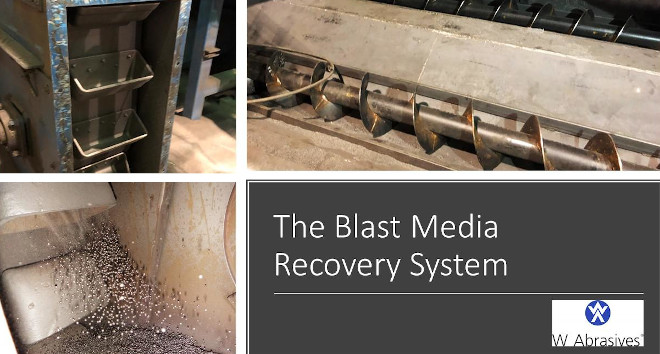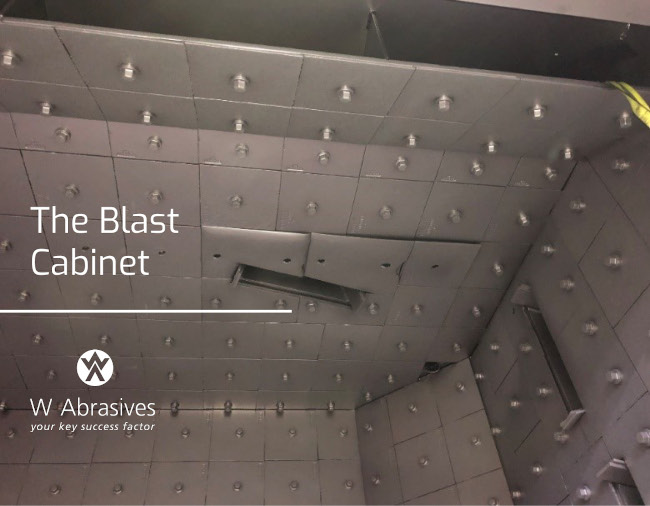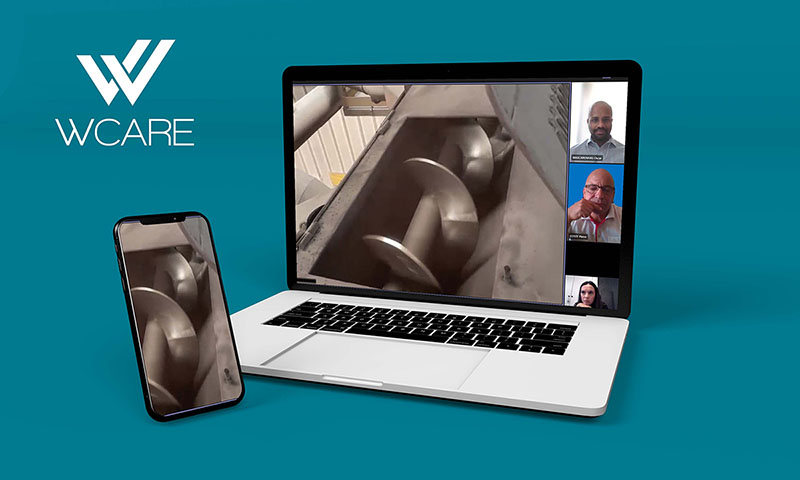What makes blasting with steel media cost effective is that the media can be used several times before it has broken down to the point that it is no longer effectively impacting the parts being cleaned. While new abrasive certainly provides the greatest impact, as it breaks down, it becomes useful in getting into the smaller nooks and crannies of the parts, providing a consistent, overall clean. To do this, it must be recovered so that it can be sent to the wheels again and again until it is small enough to be pushed out by the separator. This is where the machine’s recovery system comes into play. The recovery system is a simple concept but requires quite a bit of engineering in the design to keep the flow of abrasive consistent throughout the entire blast machine. Let us look at the basic components of the blast media recovery system in a typical machine and what to check for, maintenance wise. Keep in mind, some machines will have larger or even multiple systems, but the concept is the same across all machines: get the media that was thrown at the parts to be cleaned back up to the wheels to be used again.
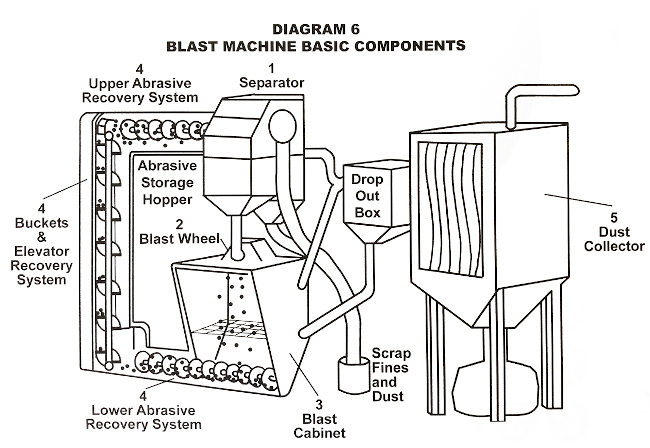
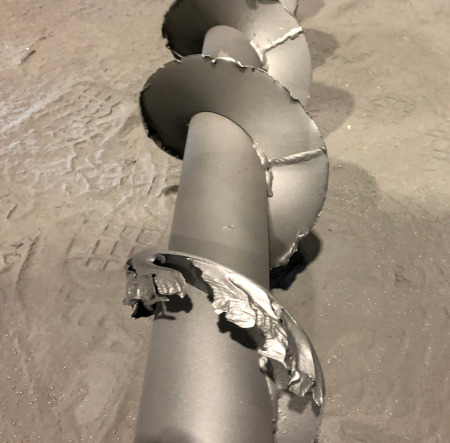
Figure 1: Worn Lower Screw limiting abrasive flow and recovery
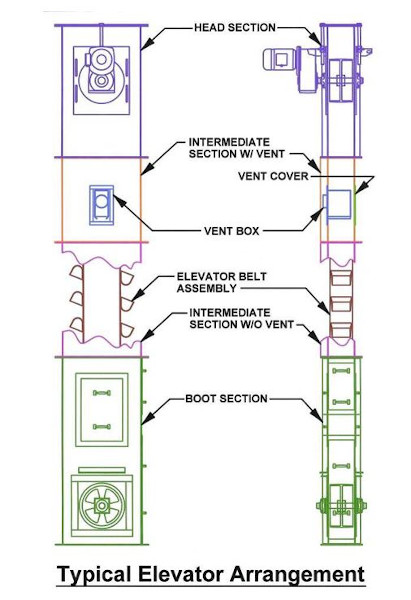

Figure 2: Belt from Bucket Elevator the needs attention!
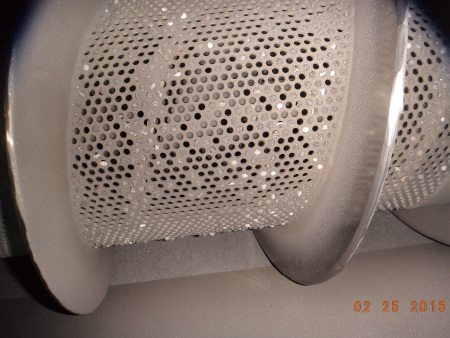
Figure 3: Clogged Rotary Screen
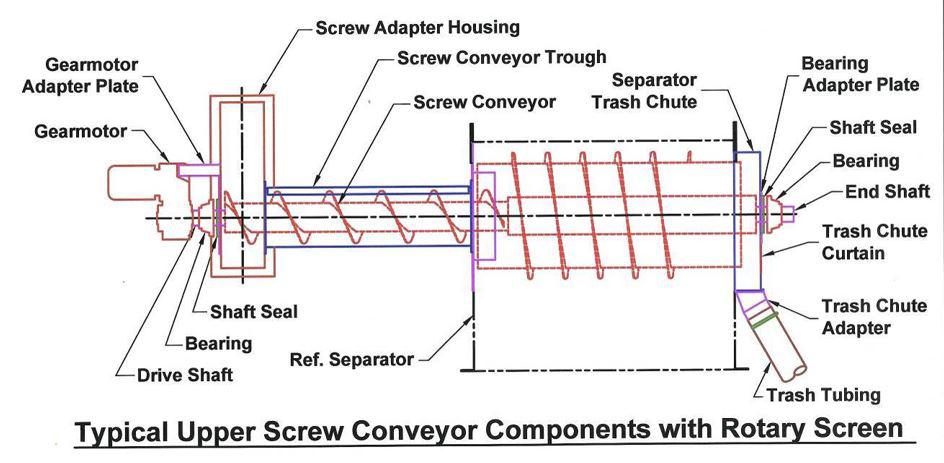

Machine diagram
1. The Lower Screw
Once the abrasive has been thrown either by wheel or air blast, the media falls to the bottom of the machine. The machine will be designed to funnel the media to one or more augers, known commonly as the lower screw. These augers collect and carry the abrasive from inside the blast cabinet to the next stage of the recovery system, the elevator. The auger system itself consists of the auger screw, the screw shaft, bearings on each end, the motor and gear box. These should be checked monthly for wear and repaired or replaced when bad. Some machines will be designed with shaker conveyor in place of the lower screw. This is usually the case when the blasting will produce a significant amount of tramp metal. The shaker conveyor will have perforations to sift the tramp metal from the abrasive before it enters the rest of the reclaim system.
Figure 1: Worn Lower Screw limiting abrasive flow and recovery
2. The Elevator
Since gravity plays a key role in the operation of the rest of the operation (the abrasive falls through the separator, then falls to a hopper and finally is fed to the wheels by gravity), the abrasive must get from the bottom of the machine back to the top. This is the elevators role. The elevator is a pulley driven belt which is lined with buckets that scoop up the abrasive from the bottom (elevator boot), carries it up and dumps it into the upper trough where another auger (upper screw) moves it to the separator. The main components of the elevator will be the elevator housing, belt and buckets, the drive pulley and bearings, the lower pulley and bearings, the shed plate (keeps the abrasive from falling back down the elevator shaft), drive motor and gearbox. Again, these should be checked monthly. Many times, elevator buckets will be worn or missing from the belt or the tracking will be off, and the elevator belt can damage the walls of the elevator housing. Missing elevator buckets can disrupt the abrasive flow through the machine. More on this later.

Figure 2: Belt from Bucket Elevator the needs attention!
3. Upper Screw
Once the elevator has brought the abrasive to the top, it dumps it into another trough that contains an auger (upper screw). This auger carries the abrasive over to the separator to be cleaned and sent back to the wheels to start the cycle over. The upper screw will also have a debris screen, known as the rotary screen covering part of the screw. The purpose of this is to sift out large debris that would otherwise block the air wash or magnetic separators. This debris is carried out a separate discard tube to be disposed of. The abrasive that falls through this screen is then carried on to be cleaned by the separator. As in the lower screw system, there will be the auger screw, bearings, drive motor and gear box which should be checked monthly as part of routine preventative maintenance. Additionally, the rotary screen should be check for holes that would allow large debris to fall into the rest of the system.

Figure 3: Clogged Rotary Screen

This covers the basics of the blast media recovery system. Often, there will be variances of the design, but the concept will remain consistent, to get the still useable blast media back to the wheels to maximize its usefulness.
Abrasive Flow
When blast machines are designed, the supportive components are designed around the calculated abrasive flow for the machine. This means that given that the wheels are running consistently, the rest of the machine is designed to be able to keep a constant amount abrasive being fed to the wheels. To explain further, let us work backwards from the wheels and start at the storage hopper which feeds the wheels. There must be enough abrasive maintained in the hoppers to keep the wheels fed throughout the entire blasting process. Otherwise, the quality of clean will diminish once abrasive runs out of the hopper. Working back from that, the separator must clean enough abrasive to keep the hopper filled. Since the separator is fed from the recovery system, the recovery system must be able to carry enough abrasive back to the separator. Additionally, the abrasive adder (whether mechanical or manual) must feed enough new abrasive into the machine to replace what has been removed by the separator to keep the whole system charged properly.
Conclusion
Given all this, you can see how important maintaining the recovery system is to the operation. It is not enough to simply carry abrasive back up to the separator. It must carry the right amount at the correct rate to prevent backups of abrasive and to feed the wheels properly. Too slow and the hopper will eventually empty; too quickly and the hopper may overflow. Missing or worn elevator buckets, worn auger flights and holes in the system can all lead to a disruption of the abrasive flow. With regular maintenance, however, this can be prevented, and your operation will continue to run smoothly.
W Abrasive Technical Team has years of expertise and offer full optimization packages for your machines. Call your Regional Sales Manager or distributor today to set up a consultation with one of our Technical Service Providers.
Follow us on LinkedIn and subscribe to our blog: The Blog of Blasting
Written by:
Chris Prouty
Technical Service Advisor, NAO
Chris.Prouty@wabrasives.com
(682) 300-1885
W Abrasive Technical Team has years of expertise and offer full optimization packages for your machines. Call your Regional Sales Manager or distributor today to set up a consultation with one of our Technical Service Providers.
Follow us on LinkedIn and subscribe to our blog: The Blog of Blasting
Written by:
Chris Prouty
Technical Service Advisor, NAO
Chris.Prouty@wabrasives.com
(682) 300-1885





